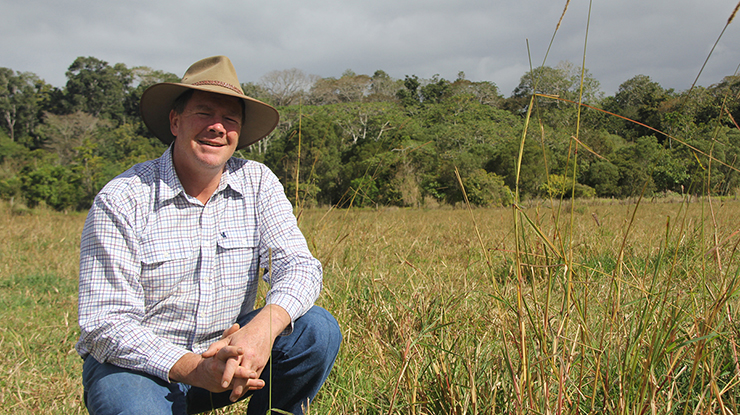 Brigalow Belt producer Peter Spies
Brigalow Belt producer Peter Spies
Producers hit PayDirt for soil performance
Producers in Queensland’s Brigalow Belt have a new tool to combat soil infertility, with MLA’s PayDirt program delving into the fertility requirements of pastures.
Soil fertility in this region has run down since the country was first cleared 40–60 years ago. Although this initial clearing led to significant nutrient releases, continuous grazing since then has depleted soil organic carbon (SOC). This means substantial fertility loss, particularly phosphorus and nitrogen.
The first PayDirt North course – part of the Profitable Grazing Systems (PGS) program – was recently run in the Maranoa region by contracted deliverers Peter Spies and Jill Alexander.
“Traditionally, producers have seen fertilising pasture as largely uneconomical – but with increasing land prices, producers are possibly better off doing more with what land they have, and addressing fertility,” Peter said.
Input decisions
Through PayDirt, producers identify what soils are worthwhile fertilising, then look at their existing pastures to decide if fertilising is a worthwhile investment.
“They need to have a good base of what are termed ‘3P’ grasses: perennial, palatable and productive,” Peter said.
“It doesn't have to be a large body of feed, but there needs to be plenty of tussock cover which can respond to rainfall and fertiliser.”
The next step is to assess soil fertility with sampling. Through the program, producers learn how to read and interpret the soil test results to recognise which nutrients are most limiting.
“We then combine these assessments into a decision matrix to make the best decision on what paddock is going to give them the best bang for their buck, and identify possible strategies to address nutrient deficiencies,” Peter said.
Hands-on learning
PayDirt involves three half-day group learning sessions over three months, and access to individual coaching to develop property-specific plans.
Participants usually take one of two approaches:
- straight fertilisation of existing improved grass pastures
- a systems-based approach, whereby pastures may have been, or will be, oversown with legumes.
“Identifying and addressing limiting nutrients, combined with sound grazing management – and possibly incorporating legume species such as desmanthus and stylos in areas receiving reliable rainfall – is likely to result in more beef per hectare, through increased pasture growth and quality,” Peter said.
“This biomass improves soil biology, resulting in improved soil health, sequestering more carbon, holding more moisture and resulting in soil stability, drought resilience and the retention of valuable topsoil.”
Peter appreciates that for many beef producers, soil testing and fertilising is a shift in management.
“I’ve seen results from improved pasture, sown on existing cropping land, as well as fertiliser placed deep in the soil. Over 14 months, an additional 174kg (218%) of beef was produced from this pasture versus conventional buffel pasture (254kg/ha of beef compared with 80kg/ha). Organic carbon increased by 27%.
“There’s different thought on fertiliser, particularly in regenerative agriculture, but improvements can be achieved through both synthetic and non-synthetic approaches, via the plant sacrificing up to 40% of its sugars through roots feeding microbes.
“PayDirt seeks to educate producers about nutrients, soil health and building pasture quality and quantity, rather than the nutrient source.”
|
Seasonal action plan If you’re considering fertilising to improve pastures, take a good look at your pastures and grazing management. You need a good 3P (perennial, palatable, productive) grass base to respond to the fertiliser. Look at the signs. Is your pasture running down? Do you have deficiency symptoms? Have your growth rates and carrying capacity been declining over time? Soil test to identify nutrient deficiencies and soil constraints and assess if inputs are required. You can’t manage what you don’t measure. Look at the climate drivers. Are conditions likely to be right to fertilise? Is the El Niño Southern Oscillation (ENSO) Index positive? Are you likely to get rain? What is the Madden–Julian Oscillation (MJO) doing? You don't want to fertilise just to have it sit there. |



